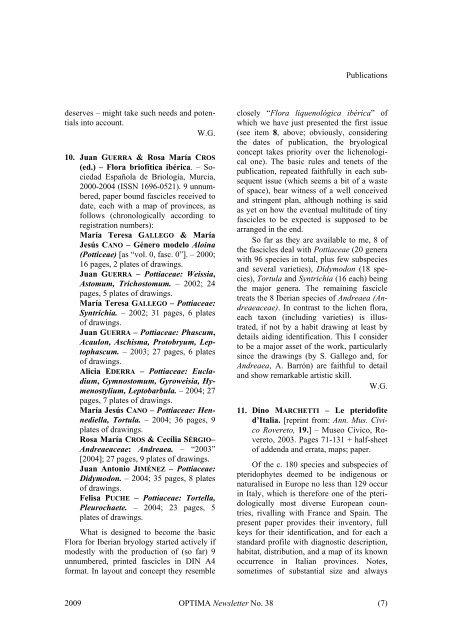OPTIMA Newsletter 38
OPTIMA Newsletter 38
OPTIMA Newsletter 38
Create successful ePaper yourself
Turn your PDF publications into a flip-book with our unique Google optimized e-Paper software.
deserves – might take such needs and potentials<br />
into account.<br />
W.G.<br />
10. 9BJuan GUERRA & Rosa María CROS<br />
(ed.) – Flora briofítica ibérica. – Sociedad<br />
Española de Briología, Murcia,<br />
2000-2004 (ISSN 1696-0521). 9 unnumbered,<br />
paper bound fascicles received to<br />
date, each with a map of provinces, as<br />
follows (chronologically according to<br />
registration numbers):<br />
María Teresa GALLEGO & María<br />
Jesús CANO – Género modelo Aloina<br />
(Potticeae) [as “vol. 0, fasc. 0”]. – 2000;<br />
16 pages, 2 plates of drawings.<br />
Juan GUERRA – Pottiaceae: Weissia,<br />
Astomum, Trichostomum. – 2002; 24<br />
pages, 5 plates of drawings.<br />
María Teresa GALLEGO – Pottiaceae:<br />
Syntrichia. – 2002; 31 pages, 6 plates<br />
of drawings.<br />
Juan GUERRA – Pottiaceae: Phascum,<br />
Acaulon, Aschisma, Protobryum, Leptophascum.<br />
– 2003; 27 pages, 6 plates<br />
of drawings.<br />
Alicia EDERRA – Pottiaceae: Eucladium,<br />
Gymnostomum, Gyroweisia, Hymenostylium,<br />
Leptobarbula. – 2004; 27<br />
pages, 7 plates of drawings.<br />
María Jesús CANO – Pottiaceae: Hennediella,<br />
Tortula. – 2004; 36 pages, 9<br />
plates of drawings.<br />
Rosa María CROS & Cecília SÉRGIO–<br />
Andreaeaceae: Andreaea. – “2003”<br />
[2004]; 27 pages, 9 plates of drawings.<br />
Juan Antonio JIMÉNEZ – Pottiaceae:<br />
Didymodon. – 2004; 35 pages, 8 plates<br />
of drawings.<br />
Felisa PUCHE – Pottiaceae: Tortella,<br />
Pleurochaete. – 2004; 23 pages, 5<br />
plates of drawings.<br />
What is designed to become the basic<br />
Flora for Iberian bryology started actively if<br />
modestly with the production of (so far) 9<br />
unnumbered, printed fascicles in DIN A4<br />
format. In layout and concept they resemble<br />
Publications<br />
closely “Flora liquenológica ibérica” of<br />
which we have just presented the first issue<br />
(see item 8, above; obviously, considering<br />
the dates of publication, the bryological<br />
concept takes priority over the lichenological<br />
one). The basic rules and tenets of the<br />
publication, repeated faithfully in each subsequent<br />
issue (which seems a bit of a waste<br />
of space), bear witness of a well conceived<br />
and stringent plan, although nothing is said<br />
as yet on how the eventual multitude of tiny<br />
fascicles to be expected is supposed to be<br />
arranged in the end.<br />
So far as they are available to me, 8 of<br />
the fascicles deal with Pottiaceae (20 genera<br />
with 96 species in total, plus few subspecies<br />
and several varieties), Didymodon (18 species),<br />
Tortula and Syntrichia (16 each) being<br />
the major genera. The remaining fascicle<br />
treats the 8 Iberian species of Andreaea (Andreaeaceae).<br />
In contrast to the lichen flora,<br />
each taxon (including varieties) is illustrated,<br />
if not by a habit drawing at least by<br />
details aiding identification. This I consider<br />
to be a major asset of the work, particularly<br />
since the drawings (by S. Gallego and, for<br />
Andreaea, A. Barrón) are faithful to detail<br />
and show remarkable artistic skill.<br />
W.G.<br />
11. 10BDino MARCHETTI – Le pteridofite<br />
d’Italia. [reprint from: Ann. Mus. Civico<br />
Rovereto, 19.] – Museo Civico, Rovereto,<br />
2003. Pages 71-131 + half-sheet<br />
of addenda and errata, maps; paper.<br />
Of the c. 180 species and subspecies of<br />
pteridophytes deemed to be indigenous or<br />
naturalised in Europe no less than 129 occur<br />
in Italy, which is therefore one of the pteridologically<br />
most diverse European countries,<br />
rivalling with France and Spain. The<br />
present paper provides their inventory, full<br />
keys for their identification, and for each a<br />
standard profile with diagnostic description,<br />
habitat, distribution, and a map of its known<br />
occurrence in Italian provinces. Notes,<br />
sometimes of substantial size and always<br />
2009 <strong>OPTIMA</strong> <strong>Newsletter</strong> No. <strong>38</strong> (7)






